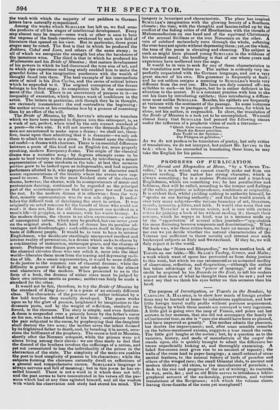The purpose of Investigation, or Travels in the Boudoir, by
CAROLINE A. HALSTED, is to show how much of foreign produc- tions may be learned at home by industrious application, and how little foreign travel really profits without previous acquirement. The design by which these morals are conveyed is very ingenious. A little girl is going over the map of France, and pours out her sorrows to her mamma, that she did not accompany the family in aContinental tour, as she is " sure she should have been so pleased, and have improved so greatly." The mother admits the pleasure, but doubts the improvement; and, after some sensible remarks on the before-mentioned axioms, suggests a tour round the room. The little girl laughs at the notion ; but, by a question as to the varieties, history, and mode of manufacture of the carpet she stands upon, she is quickly brought to admit the difference be- tween superficially looking at, and thoroughly examining. A faded fire-screen next gives rise to an account of tapestry; the walls of the room lead to paper-hangings; a small cabinet of orna- mental feathers, to the natural history of birds of paradise and others of the winged race; the small Oriental idols, to ancient and modern idolatry ; old china, to the manufacture of porcelain ; a desk to the rise and progress of the art of writing; its contents. to wax, seals, &c.; and an old Bible serves to introduce a biblio- graphical account of the authorship, preservation, and various translations of the Scriptures; with which the volume closes, leaving three-fourths of the room yet unexplored! As regards execution, hypercriticism might object to a want of dramatic character in the dialogue. The little girl is above her years ; she not only suggests recondite questions to draw her mother out, but makes reflections with all the formal wisdom of age. Mamma herself is too like a lecturer ; the style and sub- stance of her discourse are rather adapted for youth than for little children. In other respects, Travels in the Boudoir is a useful and interesting book ; full of information and facts, intermingled with a good deal of thoughtful and judicious remark. The follow- ing critical account of the qualities of china is of this kind; and will not only inform many of our readers, perhaps, but, like all general truths, is capable of a wide application. e I cannot comprehend why that old-fashioned looking china should be con- sidered so superior to the far more elegant things manufactured in England?" ‘6 In all arts, my love, there is a certain standard of excellence ; and of .course the nearer this is attained, the nearer does any art approach to perfec- tion. If, in the attempt to imitate any particular ..pecies of manufacture, a different article is produced, that article, although it may be prettier, more ele- gant, or more useful, yet remains a failure as regards the object in view ; though it may thus become the means of giving rise to a new and distinct branch of the same pursuit. The case stands precisely thus with regard to Oriental and European porcelain. The ware we wish to imitate is a half-vitrified substance,—that is to say, a material in a middle state, between thick earthenware and clear glass. Now, to whatever degree of perfection we bring either earthen- ware or glass, though each sort produced may be prettier than porcelain, yet they are no longer successful imitations of it, inasmuch as the distinguishing ,characteristic of the latter article is its being a substance between the two sorts of manufacture I have lust alluded to,—viz. a substance partly vitrified, but not wholly so. Herein, then, lies the superiority of the Chinese work ; which being composed of ingredients that ran stand the most intense degree of heat without danger of running into glass, combines the essential and true character of porcelain,—namely, its being a semi-transparent material of exquisite white- ness, uniting firmness and density with great delicacy of texture : but for want of similar ingredients in Europe, the substitutes used in its different manutac- tures approach generally so near to vitrification, that, if the greatest care were not observed in regulating the heat of the furnace employed during a part of the process, the finer articles would eventually become glass, or the more solid ones fall into the opposite extreme of possessing no transparency at all, the semblance of i only being given by the lustre of the varnish applied to the surface. You will therefore perceive that, notwithstanding the richness, elegance, and beauty of its external appearance, European porcelain must be inferior to the Oriental ware, because deficient in the qualities which compose the intrinsic excellence of the latter."



























 Previous page
Previous page